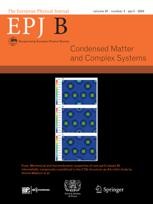Investigating the use of noise to solve inverse physical problems
New research looks at the problem of solving a physics problem starting with observational data and working backwards.
New York | Heidelberg, 19 June 2023
 The early success of physics comes mainly from solving direct or forward problems in which the physical state of a system can be described from a well-defined physical model and from governing equations. Yet, there exists a different type of problem, inverse problems, that are trickier to solve but are crucial to fields such as engineering, astrophysics and geophysics.
The early success of physics comes mainly from solving direct or forward problems in which the physical state of a system can be described from a well-defined physical model and from governing equations. Yet, there exists a different type of problem, inverse problems, that are trickier to solve but are crucial to fields such as engineering, astrophysics and geophysics.
Solving these inverse problems requires taking a set of observational data and then working backwards, or inverting the problem, to arrive at the causal factors that gave rise to the data.
A new paper in EPJ B by Universidade Federal do Rio researchers Gilberto Corso and João Medeiros de Araujo, considers the possibility of solving inverse problems in physics by using statistical information from noise statistics.
“In general, physical problems can be viewed as direct or inverse problems. In the direct case, we know the parameters of the model, and we try to find the solution,” Corso said. “In the inverse case, we know the empirical solution, and we try to find the model that has generated such a solution.”
To assess inverse problems the authors applied the use of Tsallis statistics, a collection of mathematical functions and associated probability distributions, to a seismic reflection problem that is typical in the oil industry. In this situation, waves are produced on the surface of Earth, reflect in the geologic strata and are then recorded when they once again arrive on the surface.
This data is used to build a model of Earth’s subsurface, thus constituting an inverse problem, but upon its arrival at the surface the wave data is polluted with non-useful data or “noise.” The team wanted to know if this noise could actually be used to enhance an inversion.
“The main issue with inverse problems is the noise,” Corso explained. “Different kinds of noise exist in nature that can be modelled with, for instance, Tsallis statistics. Moreover, the noise information could be used to enhance the inversion.”
Creating a simulation of a complex system polluted with noise, the scientists found that inverse problems cannot be solved with the use of Tsallis noise. This was something that Corso said was surprising, with the scientists adding he and his colleague now intend to investigate other types of noise, to determine if these are equally unhelpful in enhancing an inversion.
“We intend to explore in more detail other kinds of noise distributions to check our hypothesis over other noise models,” Corso concluded.
Reference: Silveira, A.A.Q.d., de Souza, R.F., Maciel, J.d.S. et al. Puzzle in inverse problems: Tsallis noise and Tsallis norm. Eur. Phys. J. B 96:30 (2023). https://doi.org/10.1140/epjb/s10051-023-00496-0
Further Information
For more information visit: www.epj.org
Services for Journalists
The full-text article is available here.
Contact
Sabine Lehr | Springer | Physics Editorial Department
tel +49-6221-487-8336 | sabine.lehr@springer.com
